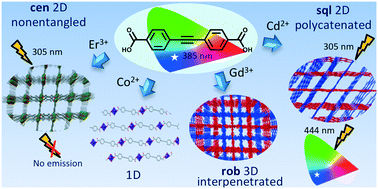A series of coordination networks constructed from the rigid ligand 4,4′-ethynylenedibenzoate: topological diversity, entanglement, supramolecular interactions and photophysical properties†
Abstract
Four coordination networks (CNs), i.e., [Co(edb)(H2O)(Py)2], 3; [Cd(edb)(DMSO)2]·0.5(DMSO), 4; [Er2(edb)3(DMSO)2(H2O)2], 5; and [Gd2(edb)3(H2O)4], 6 (edb2− = 4,4′-ethynylenedibenzoate), were synthesized and structurally characterized, and the luminescence properties of CNs 4 and 5 were investigated. In CN 3, the ligand adopts a bridging coordination mode that connects one Co(II) ion to another, resulting in a 1D CN. CNs 4 and 5 contain binuclear centers that are linked to four ligands in the chelating and bridging coordination modes. CN 4 has a 2D → 3D inclined polycatenated structure, whereas CN 5 exhibits a 3D network because the voids created by the long ligand are stabilized by the π–π stacking interactions, thereby avoiding the entanglement of the structure. CN 6 has a paddle-wheel structure with a two-fold interpenetrated rob topology. The photophysical properties of the compound H2edb and CNs 4 and 5 were studied in the solid state. Compound 2 (H2edb) displays strong absorption bands at 325 and 350 nm and emission at 385 nm. Upon complexation with Er(III), the emission was quenched. The emissions of CN 4 were due to the intraligand transitions.



 Please wait while we load your content...
Please wait while we load your content...